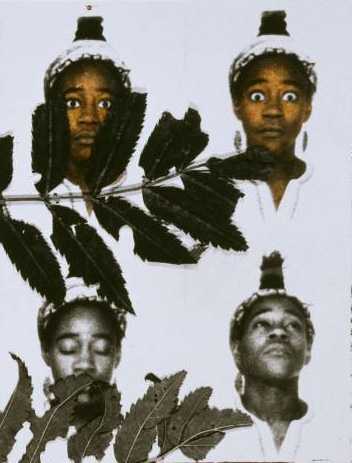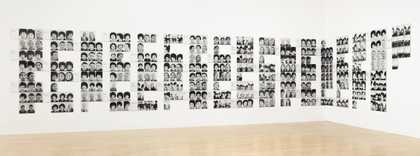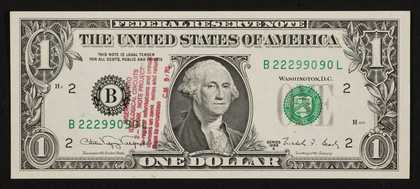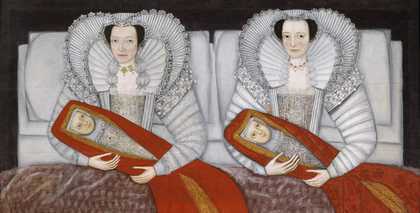Introduction
In From Tarzan to Rambo... artist Sonia Boyce explores her own sense of self in relation to media images of blackness and whiteness. The work explores the complex interweaving of black history with classic Hollywood narratives and other mass cultural forms. Boyce creates powerful stereotypes of white male supremacy, while presenting black people as foolish 'natives'.
The full title of the work is From Tarzan to Rambo: English Born ‘Native’ Considers her Relationship to the Constructed/Self Image and her Roots in Reconstruction. Sonia Boyce is the 'English born Native' of the title. In the work she explores her desire to understand her own sense of self, in response to the images and roles offered by a predominantly white-controlled media.
What does the work represent?

Sonia Boyce From Tarzan to Rambo... 1987, detail © Sonia Boyce
In an interview with Tate curator Emma Dexter, Sonia Boyce discusses some of the works imagery and themes in detail.
The buzzing bird
What does the 'buzzing bird' text mean in the speech bubble added to 'From Tarzan to Rambo'?
SB: With the From Tarzan to Rambo piece, there is a speech bubble in which what look like natives say, ‘the buzzing bird sends us a victim’. The speech is complete gobbledygook, and I suppose that one of the things I’ve realized since then, is that these black characters occupy a sort of almost underworld space – they are inarticulate and any forms of articulate speech come from white characters – the main characters. And then just to talk a bit about the Tarzan figure and the so called natives in the jungle – they were taken from jungle adventure comics from the 1940’s, as a source material, to fit into these narratives and to have, in a way, some kind of relationship to photographic images of this female figure. As I mentioned before, the natives’ (I can’t think of calling it anything else I’m afraid) speech bubble makes completely no sense.
ED: So, we’ve got jungle adventure story references and somebody saying something – is that constructed to make these people appear in a certain light?
SB: That comes directly from the comic in which it was used and, in its original context, there was basically an airplane in the sky and the natives called it a buzzing bird because, of course, they had no real relationship to the modern world.
Cartoon figures
Down one side of the work, a strip of faces taken from a 1930s stereotypical cartoon of a black child frame the work...Sonia Boyce explains their significance:
SB: The figures that are in sequence on the far left are what became popularly known as golliwog figures of pickaninnies, and were taken directly from a children’s book – I’m not quite sure which one. They were common currency – that imagery was common currency – not only for me growing up as child, but before then. These images have come from the 1930’s – one doesn’t see them as readily now but I suppose they shout out a stereotype – the kind of parodying of the black body, the black figure. Again, the eyes are wide with just a dot for pupils. I’m not sure why the mouth became this almost doughnut shape, which was white but very cartoonish – very much a parody of black features. And I think there was equivalence between the supposedly benign quality of these comic children’s stories and the films. What I was doing in this piece, was to appropriate material that was already out there in a way. And its sequence as a series of six images suggests the filmic, the frame – framed on many levels really.
Tarzan - Rambo
Boyce discusses the symbolism of Tarzan and Rambo in her work:
SB: The Tarzan figure, drawn and then painted over with whites and pinks, is almost invisible – but the title suggests that Tarzan is the main figure. At the time, not just at the time of making this piece but when I was a child, I was always puzzled by Tarzan, as to why he would want to be there. It seemed like this was a choice that he had made – that he would go and live in the jungle and live with these animals and that he would become lord of that environment. And I suppose since making this piece I’ve realized that he is this kind of mythic white figure and in some way, if one looks at those 1930’s and 1940’s films which invoke the jungle, that he usurps what he believes to be the mythic qualities of the black male – being infused in some way with the beastly, and being the king of the animal kingdom.
Also, that this white figure supersedes the black male. But it has taken a long time, since making this piece, to actually understand fully what that figure might represent. At the time, it was a curiosity to me as to why this figure wanted to be in this place and I didn’t automatically assume that there was a mastering narrative.
ED: Because you could see Tarzan, in quite a stereotyped reading. As you say, as a mythic figure representing colonialist impulses and the contradictions that that also implies; because of the desire to control, dominate and master but at the same time, as well, tacit acknowledgment of the exotic, of all sorts of projected ideas about libido and other kinds of black mastery as well. Can you talk more about how you actually present the image of Tarzan – why is he being very faint, painted out?
SB: I think, because I couldn’t quite figure how he fitted in? I mean what it actually consisted of, in terms of the making of it, was drawing him in and then painting over – and as I painted to try and fill him in, he became washed out in the process. I’ve since thought about this in relation to some of the things that Richard Dyer has talked about, in terms of whiteness being everything and nothing. As an idea, it can be almost like an ethereal gas that doesn’t evaporate but is everywhere in some way, even though in the Tarzan films, his physicality is very present. And, I think, I had quite a struggle with him, as a figure in this piece – in relation to the repeated black female.
ED: So is there an element of finding that, as you were trying to draw him in, you started actually thinking ‘No I can’t do this’. Then there’s also the fact of the white male – certainly at the time that you were making this and also the cinematic time that the piece refers to – being so dominant and prevalent. Why does he even need to be seen because we know that he’s there all the time so why should he be given this sort extra bit of promotion?
SB: But the piece hinges on the title itself – hinges on his presence but not necessarily his visibility, in a way. And so he had to be there but yes, I was struggling with how, physically, he appeared there. And in fact that was the only bit of making of the piece that was a struggle. I suppose in a way, I was trying to think about the relationship between the black female within those films and also within the question of the presentation medium. Because there are points in the first set of images of her – I mean it’s repeated – where she almost disappears as well and then she becomes much stronger and more visible, as an image, in the second stage. But I think that this kind of struggle that I had was all in relation to Tarzan – in terms of their relationship to each other, within the same frame.
...
ED: So, can you then also talk about the other white male figure, referred to in the title as Rambo – because between Tarzan and Rambo, they constitute a frame that your figure almost oscillates between, in a way. So Rambo isn’t represented at all?
SB: Visually not represented but then this piece was made at the same time as the Rambo / Sylvester Stalone films had come out and he was just kind of a replica.
ED: Can you tell us a bit more about who Rambo attacks?
SB: Rambo is like a sort of guerrilla, in the political sense.
ED: Guerrilla, yes – he’s a one-man army.
SB: I mean he is part of a team, but really he works on his own and the battleground is the jungle – he goes in there with a gun and bandanna and a few bits of rags…He goes in there and he is a survivalist in that environment. I think I’ve only seen one of those films and I was shocked at the way in which Tarzan was really being re-packaged.
I think I’m still caught up with this – its bizarreness as an extremely popular narrative. Recently, over the last few months, I went back to thinking about it and did a search about Tarzan on the web, and found a huge fan base for this narrative.
Woman's face
A woman's face – a self-portrait of the artist – is repeated across the artwork. Boyce discusses why she chose to include herself in this way in the work:
ED: So, Sonia can you tell us a bit about the most obvious thing in From Tarzan to Rambo – the fact that there is a woman’s face repeated on it twelve times and it’s a portrait of you – it’s your image. Can you tell us why you put yourself in the picture in that way?
SB: I suppose, what had been the starting point for me, to picture myself in this way, was thinking about films of the 1930’s and 1940’s, particularly the jungle adventure films or films where black people seemed to have been most obviously represented.
I suppose what I was thinking about at the time, was the way in which, as a child watching these films, these images became almost like a mirror in which I would see myself mimicking them – as if they were some kind of true representation of what black people were supposed to be like. And when I was making this piece, I was thinking about the irony of these representations – as being not just a model for white people to think about black people but for black people to think about themselves.
And so, the sequence of images has me looking in certain ways – in particular – there’s one image where my eyes are extremely wide open, recalling a particular actor, whose name I don’t remember, who was known, in the 1940’s, for his comic expressions of wide-eyed Negro. And then there are other symbolic gestures – of appearing to be in some form of trance – you know my head going back and my eyes closed. And in trying to think about each one of those looks as a kind of symbolic gesture, I was looking at a number of other artists who used the portrait in that way, in particular, some of the work of Susan Hiller, where she was using the photo mat / photo booth as a vehicle for creating her own image.
I was also looking at the work of Rasheed Araeen, who made a series called How to Paint A Self Portrait that seemed very in tune with what I was attempting to do – the idea of a self-portrait that isn’t a portrait at the same time, but is a kind of an ironic portrait. And the surrealists had always been crucial in my making images – I’m looking back and thinking of a group-photograph of all the male surrealists where their eyes are closed. I think this composite image was used for the cover of the surrealist magazine, where it looks as if they’re in a kind of semi-conscious state. So, I was using these three examples as a kind of model, in some way, for talking about consciousness and unconsciousness and about this sort of trance-like state – which was a favourite image of Hollywood at that time – the image of the black person as mystical in some way or as not fully conscious – under the spell of something – voodoo or something other-worldly.
How was it made?
From Tarzan to Rambo is composed of photographs, collaged fragments, patterns and textures. Boyce has used collage techniques in previous artworks but in making this work she developed a new approach to materials and processes.
In the interview with curator Emma Dexter, she describes how she used collage, photography and drawing in the work.
What do the critics say?
Boyce’s work offers a reconfiguring of the iconography of race. The pickaninny that wouldn’t be out of place in Tintin’s African adventure is still there. The jungle savages of Hegel and Rice Burroughs remain. But Boyce herself is also in the frame as the subject, the architect of her own representation, no longer the object, and the victim of racial myth.
Ekow Eshun
Journalist and broadcaster Ekow Eshun shares his thoughts about From Tarzan to Rambo.
This film file is broken and is being removed. Sorry for any inconvenience this causes.
In this film, curator Gus Casely-Hayford talks about From Tarzan to Rambo... as one of two Tate collection works that satirise nationalistic stereotypes.
What do you think?
Look at this selection of questions and prompts to help explore the ideas behind From Tarzan to Rambo.... They explore context, subject, object and the personal, and present different approaches to thinking about the work.
The context – hollywood and art history

Edward Ruscha
Hollywood (1969)
Tate
From Tarzan to Rambo was made in 1987, and one of its themes is the lack of a black presence within the Hollywood star system. It is also particularly about the absence of black women as positive role models. As Boyce has pointed out, despite being surrounded by black women in various states of undress Tarzan is only ever attracted to Jane, a white woman who, like himself, should not really be in this part of the world – the existence of the black women is effectively denied.
Discussion
While there has been a relatively small black presence in film for most of its history, is that still true today?
think about the following facts:
- It was only in 2002, fifteen years after Boyce made From Tarzan to Rambo, that Halle Berry became the first black actress to win an American Academy Award (Oscar), as Best Actress in a film. This is what she said:
This moment is so much bigger than me. This moment is for Dorothy Dandridge, Lena Horne, and Diahann Carroll. It’s for the women that stand beside me – Jada Pinkett, Angela Bassett and it’s for every nameless, faceless woman of colour that now has a chance because this door tonight has been opened.
- On the same night Denzel Washington became only the second black man to win the award for Best Actor, nearly forty years after the first, Sidney Poitier in 1963. In its 74 year history only five black actors (including Washington in 1990) have won the award for best supporting actor.
- Of the actresses who Berry mentioned Lena Horne was one of the few black actresses to have some degree of success during the period of the Tarzan films. In 1942 she was the first black actress to sign a long-term contract with a major Hollywood studio – MGM – in over 30 years. As part of her contract she stipulated that she would not appear in stereotypical ‘black’ roles.
Have a go
Inspired by how Sonia Boyce has addressed her sense of self in From Tarzan to Rambo..., here are some ways you can approach self-portraiture inspired by her work.
- Multiply an image of yourself using black and white photocopying, and use them as a base to create new identities for yourself. Draw or collage new clothes or hairstyles etc., either physically by drawing or digitally using photo editing software.
- Research images in magazines, newspapers or on the web of people expressing a variety of emotions. Take photos of yourself mimicking these expressions - if possible, select emotions you associate with. You could do this in a photo-booth, as a selfie or get a friend to shoot them.
- Choose some objects or possessions you think help define ‘you’ – photographs of your favourite people, flag colours or team logos etc. Use photography, photocopying or drawing to make 2D versions of them. Used the 2D versions to collage a symbolic ‘self-portrait’.
- What do you think people think about you? How might you be stereotyped? Can you find visual imagery to symbolise this? This can be added to work created from the above suggestions exist as a separate piece.



